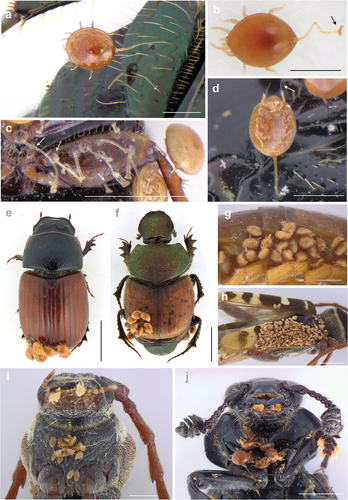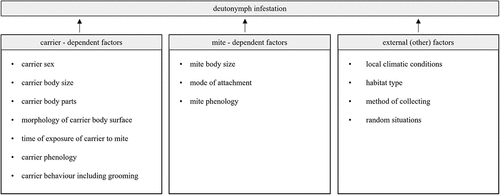Figures & data
Figure 1. Phoretic Uropodina and their carriers. (a) deutonymph of Uropoda orbicularis Müller attached via pedicel to the hind femur of Onthophagus beetle (scale bar 500 µm). (b) detached deutonymph of Uroobovella sp., a species within a species complex of Uroobovella nova Oudemans, with helically coiled pedicel; a black arrow indicates carrier terminus of the pedicel (scale bar 500 µm). (c) pedicels and deutonymphs of U. orbicularis attached to the hind femur of Aphodius beetle; white arrows indicate pedicels of variable length (scale bar 1000 µm). (d) deutonymph of U. orbicularis; note the position of the mite - the legs of the second to fourth pair are hidden in the podofossae, and the legs of the first pair with elongated setae are exposed (scale bar 500 µm). (e) deutonymphs of U. orbicularis attached to a posterior part of the elytra of Aphodius fimetarius (Linnaeus). (f) deutonymphs of U. orbicularis attached to a posterior part of the elytra of Onthophagus coenobita (Herbst); note that the mites are attached close one to the other, although the remaining dorsal body side of the beetles is free (scale bar 2000 µm). (g) deutonymphs of Oodinychus ovalis (Koch) (= Trichouropoda ovalis (Koch)) attached to a lateral body part of the centipede (scale bar 1000 µm). (h) deutonymphs of Trichouropoda sociata (Vitzthum) attached to elytra of Plagionotus detritus (Linnaeus) (scale bar 2000 µm). (i) deutonymphs of T. sociata attached to the ventral surface of the prothorax of P. detritus (scale bar 1000 µm). (j) deutonymphs of Uroobovella sp. (a species within the complex species of Uroobovella nova) attached to the ventral prothorax of the Nicrophorus beetle (scale bar 2000 µm). All images were captured under the Olympus SZ61 stereomicroscope.

Table I. Categories of phoresy in Uropodina mites according to the carrier range.
Table II. Examples of patterns of attachments in selected species of phoretic Uropodina.*

